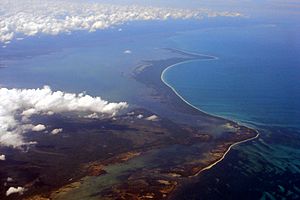Cabo Catoche facts for kids
Cabo Catoche or Cape Catoche, located in the Mexican state of Quintana Roo, is the most northern point of the Yucatán Peninsula. It is about 53 kilometers (33 miles) north of the popular city of Cancún. This special cape marks where the Gulf of Mexico meets the Caribbean Sea.
Contents
What Makes Cabo Catoche Special?
Cabo Catoche is a unique place for several reasons. It is not just a geographical point; it also has a rich history and amazing nature. Its location means it is a place where two different bodies of water meet, creating a special environment for marine life.
Where is Cabo Catoche Located?
Cabo Catoche is right at the top of the Yucatán Peninsula. This area is part of the state of Quintana Roo in Mexico. Being so far north, it acts like a natural border between the calm waters of the Caribbean Sea and the larger Gulf of Mexico. This meeting point creates strong currents and a mix of marine life.
How Far is it From Cancún?
The cape is about 53 kilometers (33 miles) north of Cancún. While Cancún is a busy tourist spot, Cabo Catoche is much quieter. It is often reached by boat trips from nearby towns like Holbox or Isla Mujeres. This makes it a perfect spot for those who love adventure and exploring nature.
A Glimpse into History
Cabo Catoche holds an important place in the history of Mexico. It was one of the first places where European explorers landed on the Yucatán Peninsula. This happened long before other parts of Mexico were explored.
The First European Landing
In 1517, a Spanish expedition led by Francisco Hernández de Córdoba arrived at Cabo Catoche. This was the first time Europeans had a major encounter with the Maya civilization in this region. The Maya people were already living there and had built impressive cities and cultures.
What Happened During the Encounter?
When the Spanish arrived, they were met by Maya warriors. There was a brief battle, and the Spanish explorers were surprised by the organized resistance they faced. This event marked the beginning of a long and complex history between the Europeans and the native people of the Yucatán. It was a very important moment in the history of both Mexico and Spain.
Nature and Wildlife at the Cape
Cabo Catoche is not just about history; it is also a haven for nature lovers. The area around the cape is home to diverse ecosystems. These include beautiful beaches, mangrove forests, and rich marine environments.
What Animals Live Here?
The waters around Cabo Catoche are full of marine life. You can find many types of fish, sea turtles, and even dolphins. The mangroves provide a safe home for many bird species, including flamingos and pelicans. It is a great place for birdwatching and seeing animals in their natural habitat.
Exploring the Ecosystems
The meeting of the Gulf of Mexico and the Caribbean Sea creates unique conditions. This allows different types of coral and marine plants to thrive. Snorkeling and diving are popular activities here. They let visitors see the colorful underwater world up close. The untouched beaches are also important nesting sites for sea turtles.
Visiting Cabo Catoche Today
Today, Cabo Catoche is a destination for eco-tourism. Many people visit to enjoy its natural beauty and learn about its history. It is a place where you can escape the crowds and experience a quieter side of the Yucatán.
What Can You Do There?
- Fishing: The waters are rich with fish, making it a popular spot for sport fishing.
- Snorkeling and Diving: Explore the coral reefs and marine life.
- Birdwatching: Spot many different bird species in the mangroves and along the coast.
- Relaxing: Enjoy the quiet, unspoiled beaches.
- Historical Tours: Learn about the first European landing and the Maya history of the area.
Protecting This Special Place
Because of its unique history and natural importance, efforts are made to protect Cabo Catoche. It is important to visit responsibly to help preserve its delicate ecosystems and historical sites for future generations. This means following local rules and respecting the wildlife.
See also
 In Spanish: Cabo Catoche para niños
In Spanish: Cabo Catoche para niños


